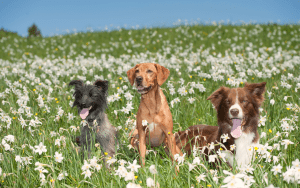
Dog Instincts
Here's a guide into what your dog's behaviors mean.
Looking at your beloved dog it can sometimes be hard to imagine that all dogs, large and small are descended from wolves. While this is easier to visualize when looking at a Husky or Malamute than it is a Basset Hound or Maltese, all of them share the same common ancestors. This is more evident when you look at dog behavior through the lens of their natural/instinctive responses. Doing so helps pet parents understand why dogs do what they do and how you can channel some of these behaviors constructively.
Let’s look at a few natural behaviors.
Play: Dogs are social, intelligent predators. Play among predators involves honing the kinds of skills they need to hunt. It also includes learning to interact with each other in acceptable ways, critical skills when group cohesion is vital for success and survival. Puppies learn to stalk, pounce, grab, trip, and wrestle with each other and thus replicate many of the behaviors they need to procure food. Pups also learn how to approach each other and adult dogs, when it is ok to be silly and playful and when enough is enough. These lessons also help them to establish their place in the group. While such a hierarchy isn’t as rigid as people used to believe, it’s actually very fluid and subject to change based on time, circumstance etc., there is little doubt that play behaviors assist dogs in learning their role in the social group.
So how is this relevant to a pet parent? When your dog wants to play with you, they naturally engage in nipping and jumping. The type of rough and tumble behavior that can be tiresome at best and painful at worst. This can escalate further when smaller children are thrown into the mix. Little ones will instinctively run away when confronted by nippy jumpy puppies often screaming as they do. These responses in our children stimulate more jumping and nipping in our dogs.
Solutions: Avoid rough, grabby play with your dogs as it encourages the wrong behavior. Praise and reward appropriate calmer greetings to strengthen the desired response. For example, if the dog is rewarded for sitting in front of you as opposed to jumping all over you, in time the sit behavior will become stronger. When the dog becomes nippy distracting them with a chew toy can often help stop this behavior. This is where products like KONG shine. Not only is KONG outstanding for keeping the dog occupied and engaged in appropriate behavior, but its unusual shape often results in it taking unpredictable bounces when the dogs are playing with it. This further stimulates interest and keeps the dog engaged in desired behavior as opposed to nipping and jumping all over you, your kids or guests.
Boredom: One of the most common causes of behavior challenges in dogs is boredom. Simply put when some dogs are left to their own devices, they can get into all sorts of trouble. Some dig, others chew, some bark excessively etc. While all of these behaviors can be caused by numerous other reasons, boredom must be considered and addressed. Wolves typically hunt in a territory the size of which varies based on the amount prey available. These amazing animals can travel up to 30 miles a day. Aside from a tremendous amount of exercise, they interact continually with each other and engage in a multitude of hunting strategies to feed themselves. Compare this to a dog left alone for hours at a time in a yard or home a fraction the size of what they might wander in the wild, with little or nothing to occupy them. When looked at this way, is it any wonder why some dogs grow bored and act out?
Solutions: Exercise! After making sure both you and your pet are healthy enough, start taking your dog for walks. You don’t have to walk/run a marathon but certainly can build up to walking with your dog 3-4x per week for 3-5 miles each time. Some folks will do a little less and some a bit more but a serious consistent exercise program will help with boredom and excess energy. Interactive toys. Give your dog something stimulating to do especially when they are left alone. This is also where KONG stands out. Stuff the KONG with delectable treats and many dogs will spend hours trying to get them out. Other dogs will play with and chew on a KONG. Combine this with exercise and obedience training and you will likely find that boredom becomes far less of a factor in your dogs’ behavior.
Note about obedience training. Teaching your dog basic cues like sit, come, down or to walk properly on a leash won’t automatically eliminate boredom. What it will do is make it easier for you to take your dog for walks in public, an important consideration when trying to give the dog more exercise. Obedience training is a fabulous way to spend constructive quality time with your pet. That may sound cliché but it is true. Finally, obedience training can be mentally challenging for dogs. This can make the dog physically tired. Many pet parents find that working with their dog for 15 minutes or so prior to leaving them alone means that when they depart, their dogs are far calmer and thus less likely to become bored or get into trouble.
Steven Appelbaum is a professional dog trainer with over 35 years of experience. He is the president and owner of Animal Behavior College the nation’s largest animal career school. He lives with his Basset Hound Truffles a dog very much in touch with her inner wolf.
 from KONG Company
from KONG Company



